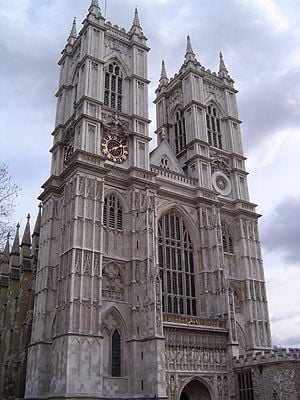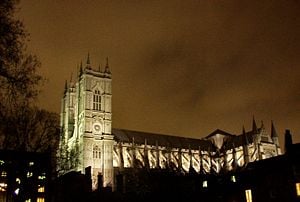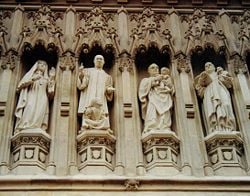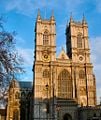Difference between revisions of "Westminster Abbey" - New World Encyclopedia
Mary Anglin (talk | contribs) (claimed for Dan Fefferman) |
m (Westminister Abbey moved to Westminster Abbey: Correct spelling) |
(No difference)
| |
Revision as of 17:06, 27 July 2007
- This article is about the church in London. For the Benedictine monastery in British Columbia, see Westminster Abbey (British Columbia).
| Westminster Palace, Westminster Abbey and Saint Margaret's Church* | |
|---|---|
| UNESCO World Heritage Site | |

| |
| State Party | |
| Type | Cultural |
| Criteria | i, ii, iv |
| Reference | 426 |
| Region** | Europe and North America |
| Inscription history | |
| Inscription | 1987 (11th Session) |
| * Name as inscribed on World Heritage List. ** Region as classified by UNESCO. | |
The Collegiate Church of St Peter, Westminster, which is almost always referred to by its original name of Westminster Abbey, is a mainly Gothic church, on the scale of a cathedral (and served as one from 1546 - 1556), in Westminster, London, just to the west of the Palace of Westminster. It is the traditional place of coronation and burial site for English monarchs.
Coronations
Since the coronations in 1066 of both King Harold and William the Conqueror, all English and British monarchs, except Lady Jane Grey, Edward V and Edward VIII, who did not have coronations and Henry III because Prince Louis of France had taken control of London, have been crowned in the Abbey. The Archbishop of Canterbury is the traditional cleric in the coronation ceremony. St Edward's Chair, the throne on which British sovereigns are seated at the moment of coronation, is housed within the Abbey; from 1296 to 1996 the chair also housed the Stone of Scone upon which the kings of Scotland are crowned, but pending another coronation the Stone is now kept in Scotland.
Burials and Memorials

Henry III rebuilt the Abbey in honour of the Royal Saint Edward the Confessor whose relics were placed in a shrine in the sanctuary. Henry III was interred nearby in a superb chest tomb with effigial monument, as were many of the Plantagenet kings of England, their wives and other relatives. Subsequently, most Kings and Queens of England were buried here, although Henry VIII and Charles I are buried at St George's Chapel, Windsor Castle, as are all monarchs and royals after George II. In 2005 the original ancient burial vault of Edward the Confessor was discovered, beneath the 1268 Cosmati mosaic pavement, in front of the High Altar. A series of royal vaults dating back to the 13th and 14th centuries was also discovered using ground-penetrating radar.
Aristocrats were buried inside chapels and monks and people associated with the Abbey were buried in the Cloisters and other areas. One of these was Geoffrey Chaucer, who was buried here as he had apartments in the Abbey where he was employed as master of the Kings Works. Other poets were buried around Chaucer in what became known as Poets' Corner. Abbey musicians such as Henry Purcell were also buried in their place of work. Subsequently it became an honour to be buried or memorialised here. The practice spread from aristocrats and poets to generals, admirals, politicians, scientists, doctors, etc. These include:
Commemorated

- Robert Baden-Powell, 1st Baron Baden-Powell, buried in Nyeri, Kenya
- Sir Winston Churchill, buried at Bladon, Oxfordshire
- Paul Dirac, buried in Florida
- Benjamin Disraeli, 1st Earl of Beaconsfield, buried at Hughenden Manor, Buckinghamshire
- Adam Lindsay Gordon, buried in Australia
- Jane Austen
- Charlotte Bronte, Emily Jane Bronte, Anne Bronte
- John Harrison, buried in St. John's Church in Hampstead
- Henry Wadsworth Longfellow, buried at Cambridge, Massachusetts
- William Shakespeare, buried at Stratford-upon-Avon
- Oscar Wilde (in a stained glass window unveiled in 1995), buried in Paris [1]
- General James Wolfe
- Ten 20th century Christian martyrs from across the world are depicted in statues above the Great West Door. Unveiled in 1998 by Her Majesty The Queen, these are, from left to right:
- St. Maximilian Kolbe
- Manche Masemola
- Janani Luwum
- St Grand Duchess Elizabeth of Russia, Russian Grand Duchess
- Martin Luther King, Jr.
- Óscar Romero
- Dietrich Bonhoeffer
- Esther John
- Lucian Tapiedi
- Wang Zhiming
Removed
The following were buried in the abbey but later removed on the orders of Charles II:
- Oliver Cromwell, Lord Protector
- Admiral Robert Blake
- John Pym
Schools
Westminster School and Westminster Abbey Choir School are also in the precincts of the Abbey. It was natural for the learned and literate monks to be entrusted with education, and Benedictine monks were required by the Pope to maintain a charity school in 1179; Westminster School may have been founded even earlier for children or novices, and the legendary Croyland Chronicle relates a story of 11th century king Edward the Confessor's Queen Editha chatting to a schoolboy in the cloisters, and sending him off to the Palace larder for a treat.
Organ
The organ was built by Harrison & Harrison in 1937, with four manuals and 84 speaking stops, and was used for the first time at the Coronation of King George VI. Some pipework from the previous five-manual Hill organ was revoiced and incorporated in the new scheme. The two organ cases, designed in the late nineteenth century by John Loughborough Pearson, were re-instated and coloured in 1959.
Link to details of the organ on the National Pipe Organ Register.
Organists
|
|
|
Transport
- Nearest London Underground stations:
- St. James's Park (District, Circle lines)
- Westminster (Jubilee, District, Circle lines)
Chapter
The Abbey is a collegiate church organised into the College of St Peter, which comprises the Dean and four residentiary Canons (one of whom is also Rector of St Margaret's Church, Westminster, and Speaker's Chaplain), and seventeen other persons who are members ex officio, as well as twelve lay vicars and ten choristers. The seventeen are the Receiver-General and Chapter Clerk, the Registrar, the Auditor, the Legal Secretary and the Clerk of the Works (the administrative officers). Those more directly concerned with liturgical and ceremonial operations include the Precentor, the Chaplain and Sacrist, the Organist, and the (honorary) High Steward and High Bailiff. The Abbey and its property is in the care of the Librarian, the Keeper of the Muniments, and the Surveyor of the Fabric. Lastly, the educational role of the Abbey is reflected in the presence of the Headmaster of the Choir School, the Headmaster and Under Master of Westminster School, and the Master of The Queen's Scholars.
The Abbey is governed by the Dean and Chapter established under the Elizabethan statute of 1560. This consists of the Dean and the four residentiary Canons.
Gallery
- Westa.jpg
Quicktime Virtual Reality Panorama of Westminster Abbey Daytime Quicktime Virtual Reality Panorama of Westminster Abbey.
See also
- List of Abbots of Westminster
- List of Deans of Westminster
- List of churches and cathedrals of London
- List of other famous burial sites
- The Unknown Warrior
- The Abbey, a 1995 BBC TV documentary film
Notes
ReferencesISBN links support NWE through referral fees
- Simon Bradley and Nikolaus Pevsner: The Buildings of England - London 6: Westminster pp. 105–207. Yale University Press 2003. ISBN 0-300-09595-3.
- Barbara Harvey, 1993. Living and Dying in England 1100-1540: The Monastic Experience (Oxford: Clarendon Press). Daily life in Westminster Abbey.
- H.V. Morton, 1951. In Search of London (London: Methuen).
- Musical Times article on Westminster Abbey organists (subscription access)
External links
- Westminster Abbey
- Keith Short - Sculptor Images of stone carving for Westminster Abbey
- Panorama of Westminster Abbey
- Mystery Worshipper Report at the Ship of Fools website
- Carved Crests for the Knights of the Bath
- A history of the choristers and choir school of Westminster Abbbey
- Adrian Fletcher’s Paradoxplace Westminster Abbey Pages — Photos
- Satellite view of Westminster Abbey at WikiMapia
| World Heritage Sites in the United Kingdom | |
|---|---|
Blenheim Palace · Canterbury Cathedral – St. Augustine's Abbey – St. Martin's Church · Bath · Cornwall and West Devon Mining Landscape · Derwent Valley Mills · Durham Castle and Cathedral · Ironbridge Gorge · Jurassic Coast · Frontiers of the Roman Empire (Hadrian's Wall) · Kew Gardens · Liverpool · Maritime Greenwich · Westminster Palace – Westminster Abbey – St. Margaret's Church · Saltaire · Stonehenge and Avebury · Studley Royal Park and Fountains Abbey · Tower of London | |
Edinburgh Old Town and New Town · Heart of Neolithic Orkney (Maeshowe • Ring of Brodgar • Skara Brae • Standing Stones of Stenness) · New Lanark · St. Kilda | |
Castles and Town Walls of King Edward I in Gwynedd (Beaumaris Castle • Caernarfon Castle • Conwy Castle • Harlech Castle) · Blaenavon | |
| Giant's Causeway | |
| Overseas territories | Henderson Island · Gough Island and Inaccessible Island · St. George's Town |
Credits
New World Encyclopedia writers and editors rewrote and completed the Wikipedia article in accordance with New World Encyclopedia standards. This article abides by terms of the Creative Commons CC-by-sa 3.0 License (CC-by-sa), which may be used and disseminated with proper attribution. Credit is due under the terms of this license that can reference both the New World Encyclopedia contributors and the selfless volunteer contributors of the Wikimedia Foundation. To cite this article click here for a list of acceptable citing formats.The history of earlier contributions by wikipedians is accessible to researchers here:
The history of this article since it was imported to New World Encyclopedia:
Note: Some restrictions may apply to use of individual images which are separately licensed.






